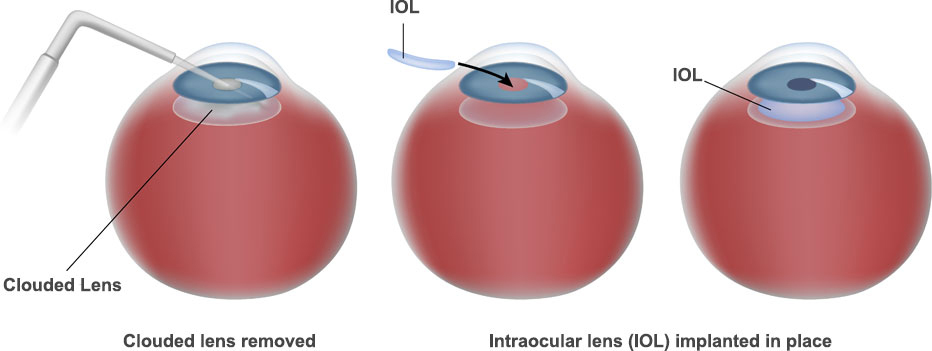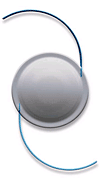Intraocular Lens (IOL)
When the eye’s natural lens is removed during cataract surgery, it needs to be replaced with an intraocular lens (IOL) in order to restore vision. At Riverside EyeCare Professionals, Drs. Michael and Sean Sumsion offer patients two different IOL types: monofocal lenses and multifocal lenses. By providing both IOL types, Dr. Sumsion can help you decide which lens best suits your lifestyle and expectations. Ultimately, this selection process enables Riverside EyeCare to provide a higher level of care and help our patients more effectively achieve their vision correction goals. While lens replacement is normally achieved through cataract surgery, patients desiring to improve their vision (and who do not qualify for cataract surgery) can have the lens implanted through a procedure called “Refractive Lens Exchange.”

Types of IOLs
Monofocal Lenses
Often considered the traditional lens, monofocal lenses are designed to correct for long distance vision. This lens is typically covered as part of normal cataract surgery. Patients who receive this lens during their cataract surgery generally experience excellent long-distance vision but may still need to wear glasses to aid intermediate or near vision. Additionally, patients with astigmatism may also need to wear glasses for distance vision as the astigmatism is likely to make vision blurry at any distance. Ultimately, patients who desire excellent long-distance vision and do not mind wearing glasses on occasion may be good candidates for monofocal lenses.
Multifocal Lenses
With age, the ability to shift focus between multiple distances begins to weaken. Multifocal lenses are an advanced lens option designed to help patients focus at any distance – near, intermediate, and far. Additionally, multifocal lenses can often reduce and even eliminate one’s dependency on glasses. At Riverside EyeCare, our ophthalmologists offer two multifocal lenses depending on your preferences and vision correction goals. These lenses are not covered as part of cataract surgery and are an additional cost. Descriptions of each lens are listed below.
TECNIS® Multifocal Lens
 TECNIS® Multifocal Lenses provide a number of benefits over traditional IOLs. Designed to reduce spherical aberration, diffraction, and refraction, this multifocal lens helps restore a full range of vision and is particularly effective at enhancing vision in dim and low-lighting settings. Additionally, TECNIS® Multifocal lenses are composed of multiple “vision zones” that optimizes vision at all ranges. Many of our patients who have received this lens enjoy greater visual freedom over those with the conventional monofocal lens.
TECNIS® Multifocal Lenses provide a number of benefits over traditional IOLs. Designed to reduce spherical aberration, diffraction, and refraction, this multifocal lens helps restore a full range of vision and is particularly effective at enhancing vision in dim and low-lighting settings. Additionally, TECNIS® Multifocal lenses are composed of multiple “vision zones” that optimizes vision at all ranges. Many of our patients who have received this lens enjoy greater visual freedom over those with the conventional monofocal lens.
Crystalens®
 Crystalens® is a state-of-the-art IOL designed to move naturally with the muscles of the eye in order to focus on objects at any distance. Unlike fixed lenses with distinct vision zones, Crystalens® works on “hinges” that enable this unique lens movement and allows the central part of the lens, or optic, to move back and forth as focal points change. This IOL was designed to resemble the eye’s natural lens and can provide excellent distance vision, as well as better contrast sensitivity. Its unique components make this another great option for those seeking near and far vision improvement post surgery.
Crystalens® is a state-of-the-art IOL designed to move naturally with the muscles of the eye in order to focus on objects at any distance. Unlike fixed lenses with distinct vision zones, Crystalens® works on “hinges” that enable this unique lens movement and allows the central part of the lens, or optic, to move back and forth as focal points change. This IOL was designed to resemble the eye’s natural lens and can provide excellent distance vision, as well as better contrast sensitivity. Its unique components make this another great option for those seeking near and far vision improvement post surgery.
TECNIS® Symfony IOL
The TECNIS® Symfony intraocular lens implant is a next-generation IOL offering an extended range of vision and improved visual acuity. Unlike traditional multifocal lenses, TECNIS® Symfony delivers vision that transitions smoothly between focal points at near, intermediate, and far distances. There are no visual “drop offs” amid distances, which creates clear, continuous vision. TECNIS® Symfony also reduces incidents of visual aberrations, such as glare and halos, which occur more often in multifocal IOLs than monofocal IOLs. Many of the patients who receive the TECNIS® Symfony IOL during cataract surgery report either reduced reliance or complete independence from glasses to see clearly.
What to Expect
- The Procedure: IOLs are implanted during cataract surgery on an outpatient basis. During cataract surgery, a small incision will be made in the eye through which the natural lens is removed and the new IOL is inserted. Following implantation, the natural pressure in the eye will cause the incision to seal without the need for stitches.
- Who will perform the procedure?: Our experienced cataract surgeons and board-certified ophthalmologists—Michael Sumsion, MD and Sean Sumsion, MD—perform all eye surgeries at Riverside EyeCare Professionals.
- What about recovery?: You will be able to return home the day of your operation. Recovery times vary per individual, but you can generally expect to return to your normal routine within a couple days of your surgery. Additionally, your ophthalmologist will provide protective eyewear and prescribe prescription eye drops for you to use following your surgery in order to aid your healing process.
- Results: IOLs from our practice can enhance your short, intermediate, and long distance vision. You will typically experience a noticeable improvement in your vision the day after your surgery. Additionally, your vision will generally continue to improve over the following weeks and months as your eyes continue to heal. Your dependence on glasses will depend on the specific type of IOL chosen for your vision correction needs and can also be affected by other existing medical conditions.
Contact Riverside EyeCare Professionals
If you would like to learn more about your intraocular lens options, or if you are interested in scheduling a consultation with one of our board-certified ophthalmologists, please contact Riverside EyeCare Professionals today. Our friendly staff will be happy to assist you in any way we can.